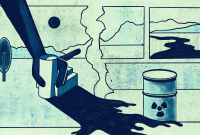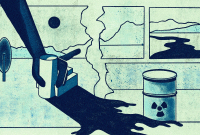Support strong Canadian climate journalism for 2025
On April 2, Alberta Premier Danielle Smith declared on X (formerly Twitter) “we are encouraged and optimistic about the role small modular reactors (SMRs) can play” in the province’s plans to “achieve carbon neutrality by 2050.”
SMRs, for those who haven’t heard this buzzword, are theoretical nuclear reactor designs that aim to produce smaller amounts of electricity compared to the current reactor fleet in Canada. The dream of using small reactors to produce nuclear power dates back to the 1950s — and so has their record of failing commercially.
That optimism about SMRs will be costing taxpayers at least $600,000, which will fund the company, X-Energy’s research “into the possibility of integrating small modular reactors (SMRs) into Alberta’s electric grid.” This is on top of the $7 million offered by Alberta’s government in September 2023 to oil and gas producer Cenovus Energy to study how SMRs could be used in the oil sands.
Last August, Saskatchewan’s Crown Investments Corporation provided $479,000 to prepare local companies to take part in developing SMRs. Alberta and Saskatchewan also have a Memorandum of Understanding to “advance the development of nuclear power generation in support of both provinces’ need for affordable, reliable and sustainable electricity grids by 2050”.
What is odd about Alberta and Saskatchewan’s talk about carbon neutrality and sustainability is that, after Nunavut, these two provinces are most reliant on fossil fuels for their electricity; as of 2022, Alberta derived 81 per cent of its power from these sources; Saskatchewan was at 79 percent. In both provinces, emissions have increased more than 50 per cent above 1990 levels.
It would appear neither province is particularly interested in addressing climate change, but that is not surprising given their commitment to the fossil fuel industry. Globally, that industry has long obstructed transitioning to low-carbon energy sources, so as to continue profiting from their polluting activities.
Canadian companies have played their part too. Cenovus Energy, the beneficiary of the $7 million from Alberta, is among the four largest Canadian oil and gas companies that “demonstrate negative climate policy engagement,” and advocate for provincial government investment in offshore oil and gas development. It is also a part of the Pathways Alliance that academic scholars charge with greenwashing, in part because of its plans to use a problematic technology, carbon capture and storage, to achieve “net-zero emissions from oilsands operations by 2050.”
Carbon capture and storage is just one of the unproven technologies that the fossil fuel industry and its supporters use as part of their “climate pledges and green advertising.” Nuclear energy is another — especially when it involves new designs such as SMRs that have never been deployed in North America, or have failed commercially.
X-energy, the company that is to receive $600,000, is using a technology that has been tried out in Germany and the United States with no success. The last high-temperature, gas-cooled reactor built in the United States was shut down within a decade, producing, on average, only 15 per cent of what it could theoretically produce.
Even if one were to ignore these past failures, building nuclear reactors is slow and usually delayed. In Finland, construction of the Olkiluoto-3 reactor started in 2005, but it was first connected to the grid in 2022, a thirteen-year delay from the anticipated 2009.
Construction of Argentina’s CAREM small modular reactor started in February 2014 but it is not expected to start operating till at least the “end of 2027,” and most likely later. Both Finland and Argentina have established nuclear industries. Neither Alberta nor Saskatchewan possess any legislative capacity to regulate a nuclear industry.
What Alberta and Saskatchewan are indulging in through all these announcements and funding for small modular nuclear reactors is an obstructionist tactic to slow down the transition away from fossil fuels. Discussing nuclear technology shifts attention from present and projected GHG emissions, while enabling a ramp-up of fossil fuel reliance in the medium-term and delaying climate action into the long-term.
Floating the idea of adding futuristic SMR technology into the energy mix is one way to publicly appear to be committed to climate action, without doing anything tangible. Even if SMRs were to be deployed to supply energy in the tar sands, that does not address downstream emissions from burning the extracted fossil fuels.
Relying on new nuclear for emission reductions prevents phasing out fossil fuels at a pace necessary for the scientific consensus in favour of rapid and immediate decarbonization. An obstructionist focus on unproven technologies will not help.
Quinn Goranson is a recent graduate from the University of British Columbia’s School of Public Policy and Global Affairs with a specialization in environment, resources and energy. Goranson has experience working in research for multiple renewable energy organizations, including the CEDAR project, in environmental policy in the public sector, and as an environmental policy consultant internationally.
M.V. Ramana is the Simons Chair in Disarmament, Global and Human Security and Professor at the School of Public Policy and Global Affairs, at the University of British Columbia in Vancouver. He is the author of The Power of Promise: Examining Nuclear Energy in India (Penguin Books, 2012) and “Nuclear is not the Solution: The Folly of Atomic Power in the Age of Climate Change” (Verso Books, 2024).







Comments
It might be true that SK and AB are using nuclear tech as a smokescreen to delay phase out of fossil fuel use for electricity generation. But that doesn't mean nuclear energy doesn't have a significant role here. SMRs have a lot of potential and are worth exploring. As ON has shown, nuclear plants can be operated for decades and provide low cost low emitting power. Electrification requires massive amounts of power, power that must be available on demand 24/7. Once again, National Observer authors have their blinders on. Less crusading, more dispassionate analysis, please.
I agree that SMRs have a definite role to play, but as soon as Danielle Smith and Scott Moe are behind something like this, makes you wonder what their real motives are here. Both premiers are in bed with the corrupt oil & gas industry deeply and leaves me very skeptical what they are up too. I trust both premiers as much as I would trust a fox in a hen house. The oil & gas industry knows no bounds to their corruption and greenwashing tactics and Smith being an oil & gas planted premier, says a lot.
You might be right, but the authors of this piece didn't provide much in the way of evidence, did they?
SMRs do not have a role to play. I haven't thought much about Ontario's nukes, maybe they're a bizarre outlier, but nobody else's is anything but expensive. While SMRs it is generally agreed are fundamentally less efficient than larger reactors. The theoretical point of SMRs is that they would be modular--that you would have a single design that could be created in something like mass production, bringing the cost of making each reactor down drastically, and making up for the relative inefficiency of their operation and then some.
In theory, that might be possible. Say if a large government said "I'm going to throw $100 billion into creating an SMR factory to make identical prefab parts, and $20 billion into making a turnkey design and testing it so we have blueprints for those parts, and then pump out $ hundreds of billions for publicly owned SMRs, and jail anyone taking payola" then maybe you could get unit prices down to fairly cheap. You'd still have all the nuclear waste and crap, and the up-front investment would be so expensive you could have just powered the country in question with solar, wind and batteries for it, but yeah, that might work.
But that's not what we have. What we have is a bunch of little grifter companies, each with a different shaky design, most of whom know perfectly well they're never going to get a project to the "generating electricity" stage, but they figure that they can ride on fossil fuel PR to get government slush money and the executives can move on with millions each once the whole thing falls apart. A few will successfully deliver a pilot project consisting of singleton small, but not particularly modular, reactors in 20 years. By which time nobody will care because the problems they're supposed to be solving will already be solved. Well, really, they're already solved NOW, it's just that the solutions are only beginning to be put into place.
The idea that cost overruns are unique to the nuclear industry expressed by several commentators is misleading.
Look at most large capital projects, whether transit systems, hospitals or pipelines. Many have significant delays and higher costs than forecasted. That seems to be inevitable in large one-off projects. And they're ignoring the billions in subsidies supplied during the long start-up to today's solar panel and turbine industries. What do the latter now have: vast economies of scale. Modular SMRs offer the same economies of scale
The sheer amount of electricity required for electrification means we need reliable base power 24/7 12 months of the year. Neither solar or turbines supply that, even with cheap battery storage.
https://canadiandimension.com/articles/view/nuclear-power-and-the-land
True, cost and time overruns are not unique to the nuclear industry. But it's significant that among the types of project you mention as frequently having such overruns, solar and wind projects are not there. That's because solar and wind projects are in fact much less plagued by such issues--perhaps because unlike "small modular reactors", the parts for solar and wind actually are modular.
We don't have time for this shit. It's 2024, and the timelines these days require big changes to be made by 2030 or 2035, that's 6 to 11 years from now! If we devote our energy to SMRs, by that time we will have some pilot projects to show for it. Wind and solar and storage projects take like 2 years to put in, not 15-20. If you want things to actually get done, like now, you put in renewables.
As to reliable yadda yadda, two points. First, the reality is that a fair number of countries have a ton more renewables than we do (and no nuclear power), and their grids have not shut down. So clearly, we can go at least as far as those countries have, and we can start worrying about what to do next if we get to where they are now and find that when they went further than that they had problems. Second, when it comes to the prairies, so build some goddamn transmission lines to BC where most of our power is very reliable hydro, and do some swaps. They rammed through pipelines, and electric lines are a lot easier, less polluting and cheaper.
I'll be frank: People quibbling about nuclear power because they have some techno-hardon for it and want to think they're more hard-headed than the environmentalist hippies they're reluctantly agreeing with about climate change, are not a misunderstood part of the solution. They are not even neutral. They are actively helping kill the planet by blocking the energy transition we need.
Look, fossil fuel interests are trying to block the transition away from fossil fuels. And, they are actively promoting nuclear. That means, fossil fuel interests believe nuclear power will help block the transition away from fossil fuels. They do not come to this belief out of sentimentality or hippie softheadedness. If you want to bet they're wrong with the planet at stake, you better have some REALLY good reasoning, and I haven't seen any.
And as Moe and Smith are promoting it, u r correct, be very suspicious! SmR and Carbon Capture are untested technology and likely won't work in time to be of any use
Did we expect something else from Moe and Smith! If u did u don't understand neoliberalism and a captured government
The irony is that Alberta drillers and frackers are poised to work with upcoming geothermal development companies (most recently, a hugely successful pilot with Eavor Energy) to both pull 7x24 energy from the earth, and even store solar power by pumping pressure into the well with it.
Nuclear isn't down and out quite yet; Alberta has had TWO "dunkelflautes" in the last 3 winters, where they were 95% gas because sun and wind both failed for days. That problem has to be solved, period, and the battery-storage for a province for days is not affordable.
But geothermal, with its own clean-firm, and now, Fervo Energy has shown it can store as well - that could turn solar and wind into a nuclear-killing combo.
The energy future is actually STILL being made in Alberta - their own government is just blind to it.
Even in Canada nuclear has proven to be very expensive. Ontario Hydro was bankrupted due to the cost of developing nuclear power. NB Power has $5 billion in debt, mostly from cost overruns from the construction and refurbishment of its nuclear power station.
Renewable power with storage continues to prove itself as a cleaner, more reliable and, importantly, affordable solution. Globally, in 2006 there was negligible power from wind & solar but in 2023 wind and solar out produced nuclear by 45%. The IEA expects that by 2030 wind and solar will individually produce 60% more than nuclear.
Thank you Tom for your comment that points to solutions. You are right about the high cost of nuclear energy - the industry could not exist without the massive federal subsidies given to AECL as well as other players. Of course research is important but there's been plenty of research on these types of reactors that have failed, as the article points out. Where is the due diligence and peer review of these reactor designs? Is anyone qualified reviewing the applications for these grants for SMR research? I strongly suspect these cash handovers for "SMR research" are all political decisions made after intensive lobbying by the industry.
Globally, wind power is expected to increase by 125% from 2023 to 2030, and solar power by over 200% in the same amount of time Together, they are projected to exceed nuclear power by 60% in that time period. Why? Because they are cheaper, faster and less risky than nuclear power.
The main reason for the push for SMR's is the ongoing need for plutonium for weapons. plutonium is refined from the waste products. They haven't solved the problem of how to store nuclear waste that remains active for 10's of thousands of years.
The military continues to “need" civilian nuclear power production in order to have a source of materials to create nuclear weapons. A CANDU reactor uses ‘natural uranium’, which means that the risk of diversion of its fuel for nefarious activities is low. However, the companies which want to make SMRs will be creating enriched uranium (near ‘military grade’) and plutonium. These materials can easily be diverted to make nuclear weapons or dirty bombs. Because, they emit “only alpha particles’, enriched uranium and plutonium can also be packaged and sent across international borders without being detected. It is the wastes from all reactors including CANDU which contain the highly radioactive material, which can be so easily detected and also so deadly.
Fortunately Canada has not seen a catastrophic accident, but it could happen if we continue to build nuclear plants. SMRs are not intrinsically any safer than the larger units; there would be just more of them for something to go wrong.
SMRs are the most expensive and worst green energy source. Wind and solar have already won the race and long term battery storage is superior to gas fired generation.
See: What if the wind doesn’t Blow? YouTube 2022
https://www.youtube.com/watch?v=XNuIwYikgsw&t=1s skip the long intro